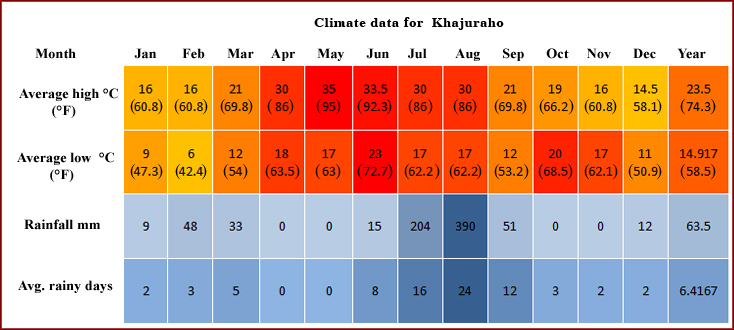Khajuraho Luxury Travel Information
Khajuraho Description:
The Khajuraho Group of Monuments is a UNESCO World Heritage site in the central Indian state of Madhya Pradesh are popularly dubbed internationally as the Kamasutra Temples of India. Many historians have contended that the Temples at Khajuraho are the finest examples of Indo-Aryan temple building. The Temples at Khajuraho are over a millennium old and are thought to have been built in the period between 950 and 1050 AD.
The Temples at Khajuraho were built by the reigning Chandela Dynasty of the area. The Temples at Khajuraho are replete with beautiful carvings depicting many aspects of life during the Chandela era in pristine detail including erotic and sexual practices of the time.
The Temple Complex at Khajuraho was thought to originally have over 85 temples, however only 25 remain standing in various stages of preservation. While the Temples of Khajuraho primarily draw their fame as the “Kamasutra Temples” of India due to the presence of grandiose and detailed erotic sculptures at all but one of the temples in the complex, erotic depictions make up around 10% of the amazingly intricate carvings at the Khajuraho Temples. The temple complex has been designed as a complete storyboard of life under Chandela rule and honors many Hindu deities, real life situations, mythical and real animals along with more sexually dynamic situations.
Listed as a UNESCO World Heritage Site in 1986, the Khajuraho Temples were thought to be abandoned to the thick jungles of Central India to spare them the destruction brought about by invaders from the north. The temples were then rediscovered by India’s British colonial administrators in 1838. The name Khajuraho is derived from the Sanskrit word “Khajuravahaka” which means “date-palm carrier”.
The Khajuraho Temples are organized in three broad groups which are known as the Western, Eastern and Southern Groups of temples. Of these, the Western Group comprises of the largest and the best preserved temples and is the usual starting point of any tour of the Khajuraho Temples.
The most striking structure at the Group of Monuments at Khajuraho is the Lakshmana Temple. The temple took over twenty years to build and is one of the best preserved in the complex. The Lakshmana Temple is dedicated to Vishnu and has some amazing statues and carvings depicting mythical beasts, charging battalions of Chandela soldiers as well as surasundaris (heavenly nymphs) in various passionate embraces with lovers. Another major temple that is a must see on any tour of Khajuraho is the Kandariya Mahadeva Temple. This is the largest temple in the complex and has over 872 statues and the largest number of representations of the female form in the Khajuraho Group of Monuments. Some of these intricate statues and carvings are over 1 meter tall. The Kandariya Mahadeva Temple has a 31 meter high Shikara (spire) with 84 sub-spires to depict the heavenly abode of the Gods in the Himalayas. The nearby Temple of Vishvanath is most famous for its large animal statues including the mythical Nandi (Shiva’s Bull vehicle) as well as a large number of elephants and a twelve pillared shrine.
Other prominent temples in the Western Group include finely constructed temples such as the Mahadeva, Devi Jagadamba, Chitragupta, Parvati, Matangesvara, Lalguan and Chausath Yogini Temples. Each of these temples represents a collection of fine statues, intricate carvings depicting both erotic scenes as well as more mundane aspects of life such as military conquest, hunting, trading, domestic chores as well as honoring mythical deities and beasts such as the half-man and half lion Sardula.
Similar to the Western Group of Temples at Khajuraho, the Eastern Group of temples are designed in the same vein with intricate sculptures and lively friezes. These temples are smaller than the grandiose Western Group however, have interesting details, excellent carvings and represent a degree of greater innovation and boldness in all types of depictive sculptures. The Eastern Group of Temples at Khajuraho also includes some Jain temples and is evidence of the religious pluralism of the Chandela era. Prominent temples in the Eastern Group include the Hanuman, Vamana, Brahma, Javari, Ghantai and the Parsvanath Temples.
The last set of temples in the Khajuraho Group of Monuments is the Southern Group. Made during the vanning days of Chandela power, these are more basic structures in the Khajuraho Temple Complex. Prominent temples in the Southern Group include the Duladeo Temple and the Bijamandala Temple which are famous for their thematic sculptures. Another famous member of the Southern Group of Temples at Khajuraho is the Chaturbuja temple, which stands out as the only temple in the complex not to feature any erotic sculptures.
Other attractions in the immediate periphery of the Khajuraho Group of Monuments include the Khajuraho Archaeological Museum. The museum has a fine collection of statues, carvings as well as remnants of destroyed temples that have been excavated at Khajuraho over the years. Another point of interest is the Adivart Tribal and Folk-art Museum which has interesting exhibits on the lifestyle, colorful arts and handicrafts of the hills tribes of Madhya Pradesh and Chattisgarh states.
Best Time to Visit Khajuraho:
The Khajuraho Group of Monuments is open to visitors all year round from dawn to dusk.
Many tourists take advantage of the pleasant weather between October and March, making it a popular time to visit the Khajuraho Group of Monuments.
In recent years, a traditional dance festival is organized in February / March of every year at the Western Group of Temples at the Khajuraho Group of Monuments. During the course of the festival, the magnificent temples at Khajuraho are floodlit and the stage is set for some of the finest dancers and classical musicians in India to enthrall visitors with their performances.

How to get to Khajuraho:
The Khajuraho Group of Monuments is located in the town of Khajuraho in the central Indian state of Madhya Pradesh (MP). Khajuraho has a small domestic airport that offers regular service to Delhi and Varanasi.
For the foreign visitor the most convenient way to get to Khajuraho is to fly to Delhi’s Indira Gandhi International airport that offers a plethora of global flight connections and then take a connecting flight to Khajuraho. Many tourists also opt to visit Khajuraho as part of a larger northern India tour that includes Delhi and Varanasi as well.
Khajuraho Highlights:
The Khajuraho Group of Monuments would interest any visitor due to the richness of its design, glorious history and intricate sculptures.
The Khajuraho Group of Monuments would hold particular interest for enthusiasts of history, architecture, romance, spirituality as well as culture and philosophy. For the photography enthusiast, the best time to photograph the Khajuraho Group of Monuments is early in the morning when the light is at its softest and you can shoot some interesting cut light shots of the various temples at the complex along with their intricate sculptures and detailed carvings.
A must have souvenir from Khajuraho is a replica of the fine temple carvings. The replicas are widely available and made from wood, stone and marble. Other specialties of Khajuraho include textiles and marble inlay work.
In recent times, tribal folk art especially original paintings made by rural artisans from the hill-tribes of Madhya Pradesh and Chattisgarh states are being increasingly bought as souvenirs by visitors coming on a tour of the Khajuraho Group of Monuments.
Appropriate Attire:
The Khajuraho Group of Monuments is located in Madhya Pradesh which is one of the most traditional and conservative states in India. While most of the temples Khajuraho Group of Monuments are not active places of worship, the Matangesvara Temple being the only exception, they are still considered as great religious icons by devout Hindus. Visitors are advised to wear clothing that is suited to the weather and covers arms, legs and shoulders.
On most days the weather in Khajuraho tends to be sunny and a tour of the Khajuraho Group of Monuments requires walking outdoors in the sun. Visitors should therefore take adequate precautions against the sun to avoid any inconvenience.

